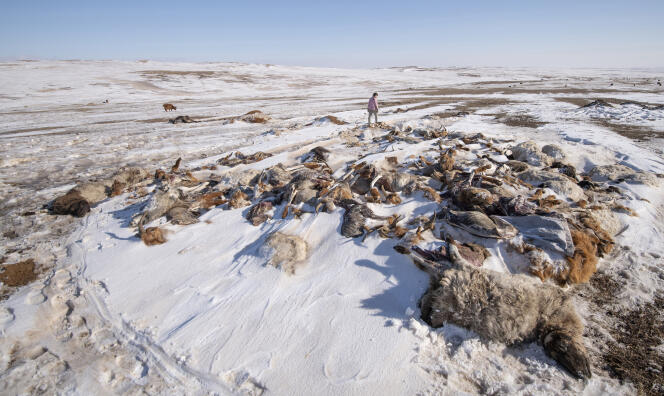


The steppe was finally free of ice and snow. White gave way to the still-dry yellow of early spring. But, on these empty expanses as far as the eye can see, patches of other colors could regularly be made out: brown, beige, black. Carcasses of horses, sheep and cows, among the more than 6.9 million animals that didn't make it through the harsh winter. Mongolians speak of a "white and iron" dzud (disaster): The snow fell suddenly at the beginning of November 2023, but a thaw melted it away. Then came the bitter cold, freezing an impenetrable layer of ice covered in deep snow from December to the end of March.
The nomads had no memory of every experiencing such temperatures, dropping below -40°C. They watched helplessly as their animals died one by one. Oyungerel Dolgsuren lost almost all of hers: Of the 400 animals she raised with her husband, Demberelsaihan, and their three children, only three sheep, around 30 goats and four cows survived. The 13 horses remaining from their 50-strong herd had wandered off into the cold and blizzard. There was no doubt they were now dead but the couple were looking for them all the same.
Every evening, the 46-year-old breeder thought back to what should have been done, if only they'd known: Sell all the animals in December. But by January, when the couple realized the scale of the disaster, it was already too late. It was impossible to cross the 40 kilometers of tracks to the small town of Munkhkhaan to sell the cattle. The herders were up to their hips in snow, and the yurt door had to be cleared to get out. In just a few minutes outside to fetch and feed the animals, Dolgsuren had frozen cheekbones. She was afraid for herself too. The animals could no longer feed themselves by scratching the ground; the ice was unbreakable, and they had grazed hooves from it. The family used up all the extra grain they had borrowed before the winter season, but nothing helped.
Weakened, the animals succumbed to cold and hunger. While sick or old animals normally take a long time to die, said the nomad, here, they all died quickly. They laid down and never got up again. Every day, there were three or four, sometimes more, 20 all at once, one terrible morning. The family made the weakest animals sleep with them in the yurt, but they were already too far gone. Some females died of exhaustion during gestation or while giving birth. "We tried everything," repeated Dolgsuren.
She led the way around the modest shelter erected to keep the ever-chilly wind off the remaining animals. Another goat had died that morning in mid-April. Even though temperatures were now much milder, the most anemic animals would continue to die for a few more days or weeks. Like all the families in the region, Dolgsuren and her husband had assembled the carcasses into a pile. The environment office has requested that they be transported to marked pits, away from waterways and homes, to avoid disease when the heat returns. Trucks will have to be brought in to clear these hundreds of animals.
You have 69.27% of this article left to read. The rest is for subscribers only.
